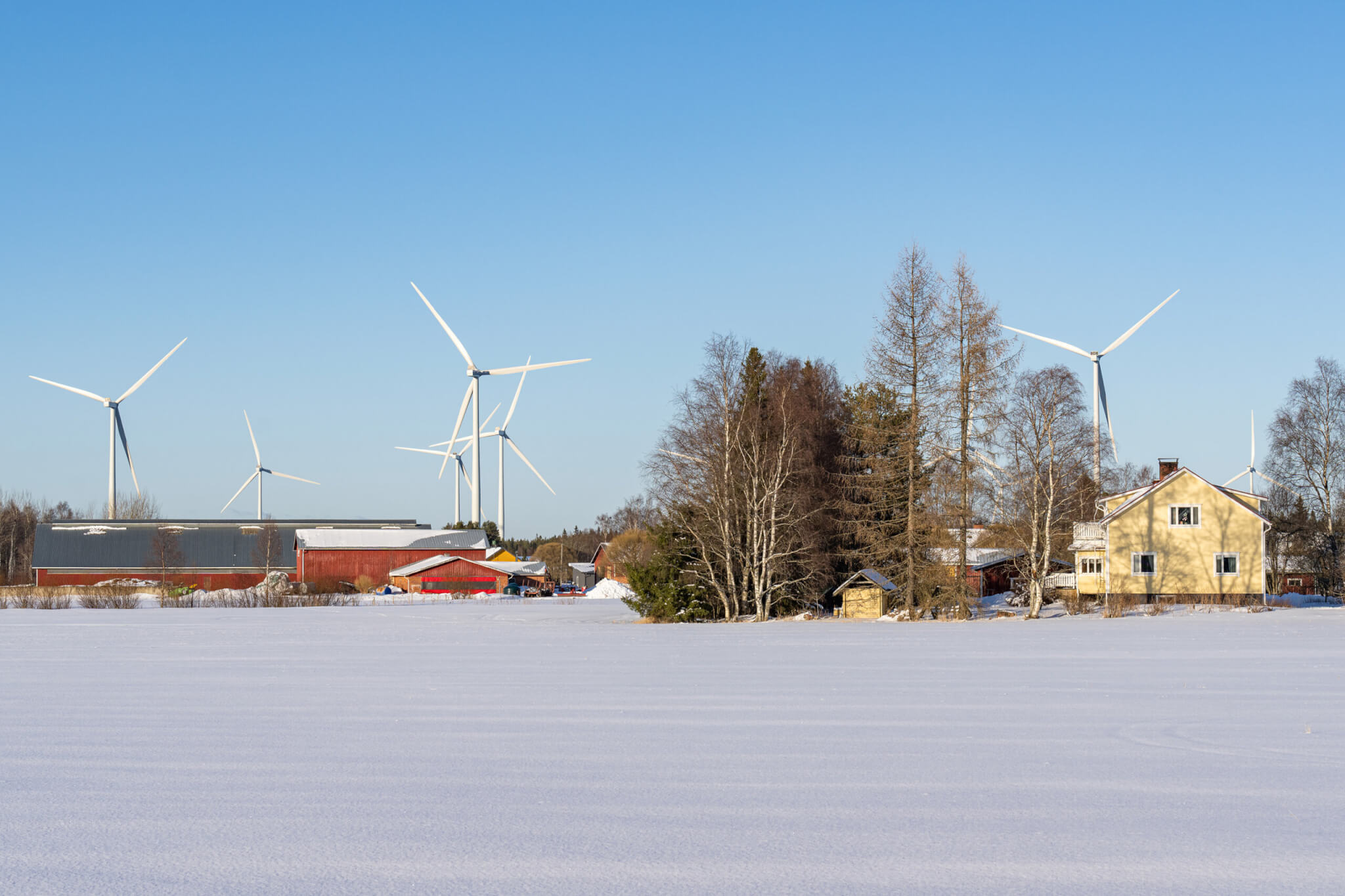
Sound regulation of wind turbines
Producing energy from the wind produces noise, as do almost all other industrial processes. The sound of wind turbines is produced both aerodynamically and mechanically. Aerodynamic sound occurs when the wind turbine blades move through the layer of air and the air swirls when the blades pass the turbine tower. The volume of aerodynamic sound is affected by, e.g. the wind speed, size of the rotor, and the rotation speed of the blades. Mechanical noise is produced in the wind turbine’s nacelle, albeit it is very low in modern wind turbines.
Measuring the basic noise level
Due to the large size of the rotor, it is not possible to measure the basic noise level. For this reason, the noise level of a wind turbine is measured at a distance of some 50 metres, and its basic level is determined according to calculations. Determining and reducing the basic noise level are calculated from the noise measurements on the presumption that “all noise is emitted from the centre of the rotor”. Therefore, the results of this method are higher than the actual levels.
With wind turbines of 3–4.2 megawatts, the calculated basic levels usually vary between 102 and 106 dB(A), and with wind turbines of 5–6 megawatts they vary between 104 and 107 bd(A). The noise level at the base of the wind turbine is about 60 decibels, which corresponds to the noise level of normal speaking voice or, for example, a washing machine. Residences are always located further from the turbines, in which case the noise is reduced before reaching the residences.
Noise regulation in Finland
In Finland, the noise levels of wind turbines are regulated with guide values for noise levels issued by a Government Decree in autumn 2015. According to the decree on guide values, the noise levels of wind turbines in the outdoor areas of permanent or holiday residences must not exceed 40 dB(A) at night or 45 dB(A) during the day. The guide value for outdoor areas in national parks is 40 dB at all times of the day and night. The permitted noise levels of wind turbines in the vicinity of residences are 5–10 dB(A) lower than the noise levels permitted for other human activities.
An on-shore wind farm consisting of industrial-scale turbines is below the 40 dB noise level normally at a distance of 700–1,000 metres from the nearest turbine, depending on the number of turbines, the terrain, vegetation, and so forth.
In addition, the background noise of wind often exceeds the 40 dB(A) noise level when the wind is so high that the wind turbine is in operation. On shores and at sea, the noise of the waves adds to the background noise level.
It is often not the noise level, but the annoyance caused by it that is significant, and this makes it problematic to estimate the noise impacts. According to studies, the annoyance of noise depends on many different factors, such as the visibility of turbines, potential financial gains, individual sensitivity to noise, trust in the local authorities, and so forth.
In Finland, there are clear instructions for the authorities with regard to the modelling and measuring of the noise of wind turbines. The modelling instructions are used in the planning of the location of turbines. The measuring and modelling of wind turbine noise are always carried out according to the noise modelling and measurement guidelines drawn up by the Ministry of the Environment in 2014. Harmonised guidelines enable noise assessment that is of uniform quality throughout Finland. When measuring noise, for example, it is worth noting that the measurement always requires stopping the turbines in order to establish the background noise level.
Modellings and measurements are consistent with one another
The modelling guidelines have also been tested in practice in Finland. The noise of wind turbines has been measured in several wind farms that are in operation. At the same time, the noise of wind turbines has been modelled using the above-mentioned guidelines. The results show that the modelling results are highly consistent with the measurement results, with modelling slightly exaggerating low frequencies. (Hongisto, Keränen & Oliva 2017.)
The Ministry of the Environment has published three sets of guidelines for rating and verifying the noise of wind turbines. The guidelines entered into force on 28 February 2014 and they are in force until further notice.
Government decree on guide values for the outdoor noise level of wind turbines 1107/2015
Other

Distance to residences
Legislation does not provide for the minimum distance between wind turbines and residences. However, it has regularly been claimed in public debate that the Ministry of Social Affairs and Health would recommend a minimum distance of two kilometres between wind turbines and holiday or permanent residences. However, this is based on a misunderstanding. The “setback distance of two kilometres” has remained a live claim as a result of a statement on the phased regional land use plan for wind power for South-West Finland issued by the Ministry of Social Affairs and Health in 2013 on the basis of incorrect interpretation of guidelines provided in the United Kingdom. Since then, the Ministry of Social Affairs and Health has corrected its position and stated that there is no reason to comply with any categorical distance limit. Notwithstanding, a few municipalities have decided that wind turbines must not be planned at a certain distance from residences. Due to the planning monopoly, municipalities can freely determine on land use in their areas although there are no legal stipulations with regard to minimum distances.
Legislation
How is the relationship between residences and wind power approached in legislation as there are no specified minimum distances? The idea is to take into account the impacts of wind turbines, especially noise and the shadow flicker caused by the rotating blades, already in the planning stage. As a rule, the building of wind turbines requires a plan, which is subject to the Land Use and Building Act (132/1999) that stipulates that the impacts of the plan must be assessed to a sufficient extent in order to reconcile the needs of land use. In most cases, to implement a wind power project, a local master plan is drawn up in accordance with section 77a of the Land Use and Building Act that governs the building of wind power. Therefore, in addition to meeting the general content requirements laid down in legislation, it is necessary to make sure that the local master plan guides the building and other use of the areas to a sufficient extent and that the planned wind power construction and other land use conform with the landscape and the environment. This required, among others, an assessment of noise impacts and taking them into account.
With respect to the noise of wind power, a separate Government Decree on guide values for the outdoor noise level of wind turbines (1107/2015) was issued in 2015. In addition, in terms of indoor noise, the decree of the Ministry of Social Affairs and Health on health-related conditions of housing and other residential buildings and qualification requirements for third-party experts (545/2015) shall also be complied with. The decree on the noise level of wind power lays down the guide values for planning that must be taken into account, for example, when drawing up a component master plan. These guide values for noise levels, concerning residential and holiday homes, are 45 dB in daytime and 40 dB at night-time. As it is a question of operations that are still under plan, the noise impacts are basically assessed on the basis of planning data and modelling. The Environmental Administration guidelines on the modelling of wind turbine noise (2/2014) are consistently complied with in modelling procedures and, for example, the guidelines take a position on the type of initial data that modelling must be based on. When a plan that enables a wind power project is drawn up so that the noise impacts estimated through modelling remain within the guide values, in principle, the plan meets the requirements of the Land Use and Building Act in that respect.
The planning guide values according to the decree are not limit values that restrict operations, but their purpose is to guide land use planning so that the operation of wind turbines will not cause such disturbing impacts that it would be necessary to regulate the operation of wind turbines with an environmental permit at a later date. Therefore, wind turbines are not required to have an environmental permit directly by law as the need for a permit is determined on the basis of possible impacts. However, if an environmental permit is required, the preconditions for granting a permit must be examined on the basis of impact assessments and in relation to guide values laid out in the decree. It is a precondition for granting an environmental permit that, taking the provisions in the permit and the location of the operations into account, the operations will not cause adverse health impacts or unreasonable burden referred to in the Adjoining Properties Act. If the impacts of the operations remain within the guide values according to the government decree, the noise impacts do not pose a health risk or unreasonable burden referred to in legislation, in which case the preconditions for granting the permit are met in this respect.
Issues concerning the location are decided separately for each project
According to legislation, therefore, the location of residences and wind power must be examined on the basis of the impacts. The justification based on impact has also been confirmed in the legal practice of the Supreme Administrative Court where, on one hand, it has been stated that the guide values direct both the planning of land use and the consideration of environmental permits and, on the other hand, it confirms that assessment must be based on the estimated impacts of the project, not on the experience of individual people. This is well illustrated by the yearbook decision KHO 290/2019 concerning environmental permits, as well as by the decision KHO 290/2019 concerning the component master plan for wind power. In the yearbook decision, the Supreme Administrative Court states that the objective of the guide values is to prevent noise nuisance in general, and it is not possible to take into account any individual differences in experiencing noise in their interpretation. In addition, the justifications for both decisions state specifically that there is no binding regulation in Finland concerning the distance of wind turbines from residences.
In this regard, in order to minimise harmful impacts, the impacts of wind power, especially its noise impacts, must be assessed and taken into account as much as possible in the planning of land use when different operations are reconciled. Issues concerning the location of wind turbines are decided separately for each project as confirmed in legal practice. The planned location in relation to residences is part of the initial data for assessment, and therefore a sufficient distance in terms of residences will be assessed as part of the impact assessment of the project. In other words, there is no generic rule with regard to the minimum distance between residences and wind turbines.

Infrasound
Wind turbines also produce infrasound. Infrasound is a sound with a frequency (Hz) of less than 20 Hz. Depending on its strength, infrasound can be either audible or remain below the lower limit of audibility. In most cases, however, we do not hear the infrasound in our environment.
Infrasound that is below the lower limit of audibility, i.e. inaudible, is present everywhere in our environment. It is generated, for example, from atmospheric pressure variations, wind, vibrations of structures, swinging or, for example, running steps on a certain type of base. Infrasound below the lower limit of audibility is also generated in various industrial processes, such as wind turbines. According to studies, the infrasound pressure level of wind turbines remains significantly below the lower limit of audibility.
Study on infrasound
Infrasound is subject to the same laws as any other sound, and its potential health impacts are also generated in the same situations as other kind of sound. According to a scientific study, it has not been proved that infrasound has any health impacts as long as it is inaudible. (e.g.. Hongisto & Oliva 2017.)
In Finland, the health impacts of infrasound generated by wind power have been examined in several studies, e.g. in a government-funded project (2020), in which the impact of infrasound was studied extensively with long-term sound measurements, questionnaires conducted in wind power areas, and listening and physiological tests.
According to the results of listening tests carried out in a laboratory, the test persons were unable to detect infrasound in the sound samples, and infrasound had no impact on the perceived annoyance of the sound. Moreover, no difference in stress indicators between different groups or sound samples were found in the physiological measurements. Although some of the nearest residents of the wind power areas stated in the questionnaire that their symptoms were connected to the wind turbines, the results of the survey do not support claims that the infrasound of wind power would cause a health hazard.
According to research results, symptoms related to wind turbines are therefore not explained by the infrasound of wind turbines. The results show that symptoms can be explained by the fact that wind turbines are perceived to be annoying and that they are regarded as a health risk. It is also possible that symptoms and illnesses that are unrelated to the infrasound of wind turbines are interpreted to be caused by them. The interpretations are also affected by the ongoing public debate.
Sources and further information: